Introduction to Views
Introduction to Views
Uniting Some Records
Introduction
Consider the following tables:
USE Exercise1; GO DROP TABLE HumanResources.Employees; GO DROP TABLE HumanResources.Contractors; GO
CREATE TABLE HumanResources.Employees ( EmployeeNumber nchar(9), FirstName nvarchar(20), LastName nvarchar(20), HourlySalary money, [Status] nvarchar(20) default N'Employee' ); GO CREATE TABLE HumanResources.Contractors ( ContractorCode nchar(7), Name1 nvarchar(20), Name2 nvarchar(20), Wage decimal(6, 2), [Type] nvarchar(20) default N'Contractor' ); GO INSERT INTO HumanResources.Employees(EmployeeNumber, FirstName, LastName, HourlySalary) VALUES(N'2930-4708', N'John', N'Franks', 20.05), (N'8274-9571', N'Peter', N'Sonnens', 10.65), (N'6359-8079', N'Leslie', N'Aronson', 15.88); GO INSERT INTO HumanResources.Contractors(ContractorCode, Name1, Name2, Wage) VALUES(N'350-809', N'Mary', N'Shamberg', 14.20), (N'286-606', N'Chryssa', N'Lurie', 20.26); GO
Sometimes, either for the sake of comparing records or for preparing them for any operation, you may want to display the records of more than one table. To support the ability to select records of various tables and show them together, you use the UNION operator. The basic formula to follow is:
SELECT WhatField(s) FROM OneTable UNION SELECT WhatField(s) FROM AnotherTable;
There are rules you must follow:
The columns don't have to have the same name. Here is an example of getting a union of all records from both tables:
SELECT * FROM HumanResources.Employees UNION SELECT * FROM HumanResources.Contractors; GO
This would produce:
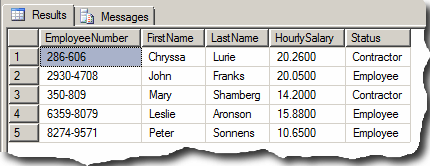
If you use the above formula, the records of all SELECTed tables would be included in the result. As an alternative, you can set a condition for the table(s) to exclude some records. You can set a condition on only one table, some tables, or all tables, but each table must have its own condition. Here is an exmple that unites some records of the above employees whose name end with s and the contractors who earn more than 20.00:
SELECT * FROM HumanResources.Employees WHERE LastName LIKE N'%s' UNION SELECT * FROM HumanResources.Contractors WHERE Wage >= 20.00; GO
This would produce:
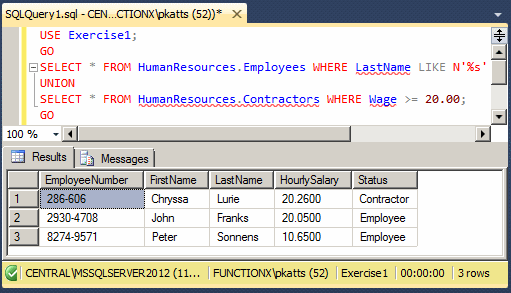
|
|
USE LPM2; GO SELECT * FROM Rentals.Tenants; GO SELECT * FROM Rentals.Customers; GO
USE LPM2;
GO
SELECT t.TenantCode, t.FirstName, t.LastName,
t.MaritalStatus, t.PhoneNumber, t.EmailAddress
FROM Rentals.Tenants t
UNION
SELECT c.AccountNumber, c.FirstName, c.LastName, c.[Status], c.Phone, c.Email
FROM Rentals.Customers c;
GO

USE LPM2;
GO
SELECT r.RegistrationNumber [Regist #],
r.RegistrationDate [Regist Date],
r.TenantCode [For Account #],
r.PropertyNumber [For Prop #],
r.RentStartDate [Rent Start On]
FROM Rentals.Registrations r
UNION
SELECT a.AllocationID, a.DateAllocated, a.AccountNumber,
a.ApartmentNumber, a.DateOccupiedFrom
FROM Rentals.Allocations a;
GO
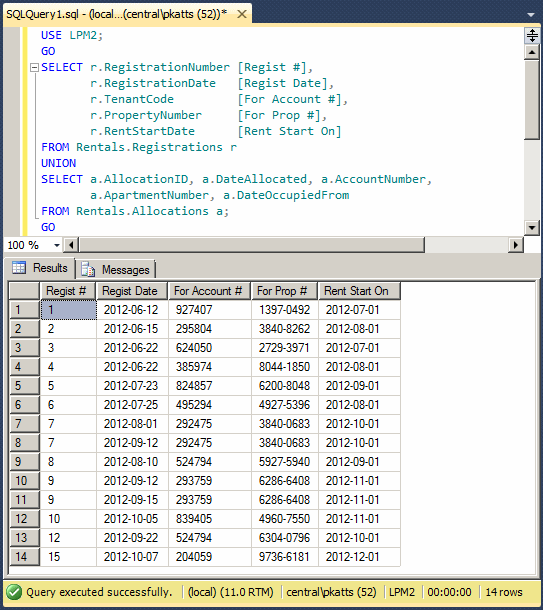
By default, when UNION is used, the database engine arranges the records based on the first column. This means that if the first column is number-based, the records would be sorted in increment based on that column. If the first column is character-based, the list would be given with that column in alphabetical order. As an alternative, you can ask the database engine to include the records as they are made available, that is, the records of the first table, followed by those of the second table, and so on. To give this instruction, add the ALL keyword after UNION. The formula to follow is:
SELECT WhatField(s) FROM OneTable
UNION ALL
SELECT WhatField(s) FROM AnotherTable;
Here is an example:
SELECT * FROM HumanResources.Employees UNION ALL SELECT * FROM HumanResources.Contractors; GO
This would produce:
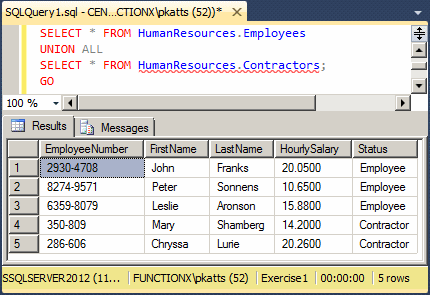
|
|
USE LPM2;
GO
SELECT r.RegistrationNumber [Regist #],
r.RegistrationDate [Regist Date],
r.TenantCode [For Account #],
r.PropertyNumber [For Prop #],
r.RentStartDate [Rent Start On]
FROM Rentals.Registrations r
UNION ALL
SELECT a.AllocationID, a.DateAllocated, a.AccountNumber,
a.ApartmentNumber, a.DateOccupiedFrom
FROM Rentals.Allocations a;
GO

Copying From Many Tables
You can use the ability to copy records in order to get records from two or more tables and add them to a another table.
The formula to follow is:
INSERT INTO TableName SELECT WhatField(s) FROM OneTable UNION [ALL] SELECT WhatField(s) FROM AnotherTable;
Here is an example:
USE LPM1;
GO
INSERT INTO Listing.Apartments
SELECT props.PropertyNumber,
props.[Address],
props.UnitNumber,
props.City,
props.[State],
props.ZIPCode,
props.Bedrooms,
props.Bathrooms,
props.MonthlyRate,
props.SecurityDeposit
FROM Listing.Properties props
UNION
SELECT condos.CondoCode,
condos.[Address],
condos.CondoNbr,
condos.City,
condos.[State],
condos.PostalCode,
condos.Beds,
condos.Baths,
condos.Rent,
condos.SecDepot
FROM Listing.Condominiums condos
UNION
SELECT alex.ApartmentCode,
alex.[Address],
alex.ApartNbr,
alex.City,
alex.[State],
alex.ZIP,
alex.Bedrooms,
alex.Bathrooms,
alex.MonthRent,
alex.InitialDeposit
FROM Listing.AlexandriaApartments alex;
GO
Here is an example that displays the results
USE LPM1;
GO
SELECT aparts.PropertyNumber N'Prop #',
aparts.[Address],
aparts.UnitNumber N'Apart #',
aparts.City,
aparts.[State],
aparts.ZIPCode N'ZIP Code',
aparts.Bedrooms Beds,
aparts.Bathrooms Baths,
aparts.MonthlyRate Rent,
aparts.SecurityDeposit Deposit
FROM Listing.Apartments aparts;
GO
ss F5
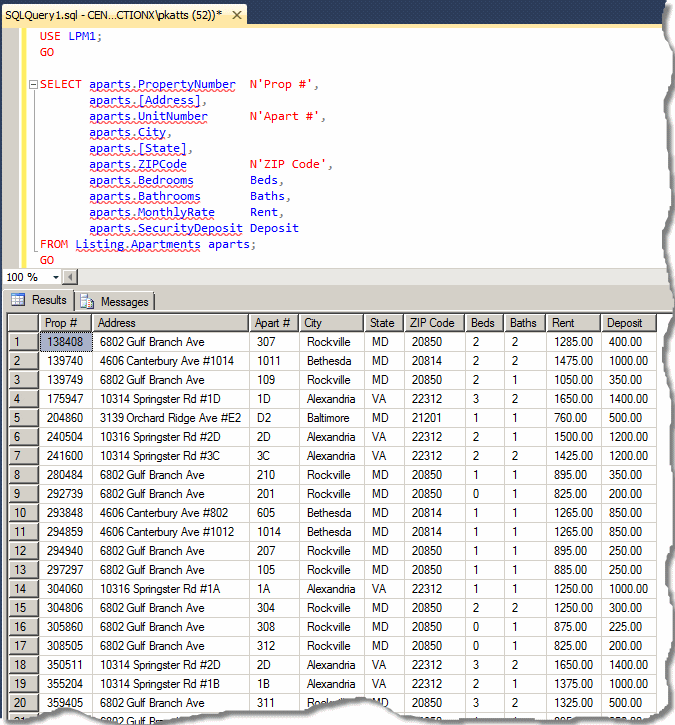
Practical Learning: Updating the Database
- Type the following code:
USE LPM2; GO /* Change the property number where a record from Alexandria has the name property number as an apartment from Rockville */ UPDATE Listing.Properties SET PropertyNumber = N'3840-0002' WHERE (PropertyNumber = N'3840-8262') AND (City = N'Alexandria'); GO UPDATE Listing.Properties SET PropertyNumber = N'6200-0008' WHERE (PropertyNumber = N'6200-8048') AND (City = N'Alexandria'); GO UPDATE Listing.Properties SET PropertyNumber = N'3840-0003' WHERE (PropertyNumber = N'3840-0683') AND (City = N'Alexandria'); GO UPDATE Listing.Properties SET PropertyNumber = N'6286-0008' WHERE (PropertyNumber = N'6286-6408') AND (City = N'Alexandria'); GO -- Harmonize the security deposits based on the rate of each house UPDATE Listing.Properties SET SecurityDeposit = 500 WHERE MonthlyRate >= 800; GO UPDATE Listing.Properties SET SecurityDeposit = 600 WHERE MonthlyRate >= 900; GO UPDATE Listing.Properties SET SecurityDeposit = 700 WHERE MonthlyRate >= 1000; GO UPDATE Listing.Properties SET SecurityDeposit = 800 WHERE MonthlyRate >= 1200; GO UPDATE Listing.Properties SET SecurityDeposit = 1000 WHERE MonthlyRate >= 1500; GO -- Add to the Rockville table of tenants the missing columns from the Alexandria table of customers ALTER TABLE Rentals.Tenants ADD DateCreated date; GO ALTER TABLE Rentals.Tenants ADD DateCreated date; GO ALTER TABLE Rentals.Tenants ADD EmergencyName nvarchar(40); GO ALTER TABLE Rentals.Tenants ADD EmergencyPhone nvarchar(20); GO /* Change the tenants account numbers from Alexandria where they are the same as tenants in Rockville */ UPDATE Rentals.Customers SET AccountNumber = N'292000' WHERE AccountNumber = N'292475'; GO UPDATE Rentals.Customers SET AccountNumber = N'293000' WHERE AccountNumber = N'293759'; GO UPDATE Rentals.Customers SET AccountNumber = N'295000' WHERE AccountNumber = N'295804'; GO UPDATE Rentals.Customers SET AccountNumber = N'524000' WHERE AccountNumber = N'524794'; GO UPDATE Rentals.Customers SET AccountNumber = N'824000' WHERE AccountNumber = N'824857'; GO -- Copy the Alexandria tenants to those in Rockville INSERT INTO Rentals(TenantCode, DateCreated, FirstName, LastName, MaritalStatus, NumberOfChildren, PhoneNumber, EmailAddress, EmergencyName, EmergencyPhone) SELECT AccountNumber, DateCreated, FirstName, LastName, [Status], Children, Phone, Email, EmergencyName, EmergencyPhone FROM Rentals.Customers; GO /* Change the records of the Alexandria registrations based on the properties numbers and the accounts numbers that were changed earlier */ UPDATE Rentals.Allocations SET ApartmentNumber = N'3840-0002', AccountNumber = N'295000' WHERE AllocationID = 2; GO UPDATE Rentals.Allocations SET ApartmentNumber = N'6200-0008', AccountNumber = N'824000' WHERE AllocationID = 5; GO UPDATE Rentals.Allocations SET ApartmentNumber = N'3840-0003', AccountNumber = N'292000' WHERE AllocationID = 7; GO UPDATE Rentals.Allocations SET ApartmentNumber = N'6286-0008', AccountNumber = N'293000' WHERE AllocationID = 9; GO -- Create a new Registrations table to use an identity column CREATE TABLE Rentals.Agreements ( AgreementID int identity(1, 1) not null, RegistrationDate Date, EmployeeNumber int, -- Processed By TenantCode nvarchar(10), -- Processed For PropertyNumber nvarchar(10) not null, RentStartDate date ); GO -- Add the Rockville regustrations to this table INSERT INTO Rentals.Agreements(RegistrationDate, EmployeeNumber, TenantCode, PropertyNumber, RentStartDate) SELECT RegistrationDate, EmployeeNumber, TenantCode, PropertyNumber, RentStartDate FROM Rentals.Registrations GO -- Then add the Alxandria registrations to the new table INSERT INTO Rentals.Agreements(RegistrationDate, TenantCode, PropertyNumber, RentStartDate) SELECT DateAllocated, AccountNumber, ApartmentNumber, DateOccupiedFrom) FROM Rentals.Allocations; GO /* Change the registrations numbers of the Alexandria tenants based on the new identity numbers of the Agreements table */ UPDATE Rentals.Receipts SET PaymentForAllocationNumber = 11 WHERE PaymentForAllocationNumber = 2; GO UPDATE Rentals.Receipts SET PaymentForAllocationNumber = 12 WHERE PaymentForAllocationNumber = 5; GO UPDATE Rentals.Receipts SET PaymentForAllocationNumber = 13 WHERE PaymentForAllocationNumber = 7; GO UPDATE Rentals.Receipts SET PaymentForAllocationNumber = 14 WHERE PaymentForAllocationNumber = 9; GO UPDATE Rentals.Receipts SET PaymentForAllocationNumber = 15 WHERE PaymentForAllocationNumber = 12; GO UPDATE Rentals.Receipts SET PaymentForAllocationNumber = 16 WHERE PaymentForAllocationNumber = 15; GO -- Add the Alexandria payments to the Roclville's INSERT INTO Rentals.Payments(PaymentDate, EmployeeNumber, RegistrationNumber, AmountPaid, Notes) SELECT PaymentAmt, PaymentForAllocationNumber, DateReceiptMade, ReceiptDescription FROM Rentals.Receipts; GO- To execute, on the main menu, click Query -> Execute
- Close Microsoft SQL Server
- When asked whether you want to save, click No
|
|
||
| Previous | Copyright © 2009-2022, FunctionX | Next |
|
|
||